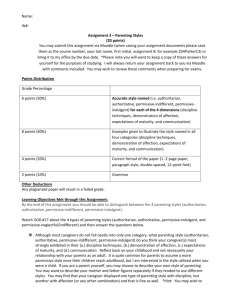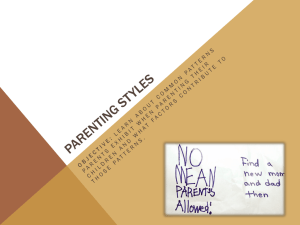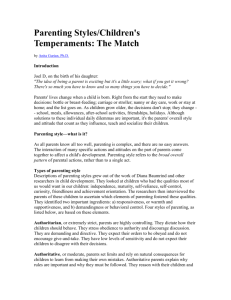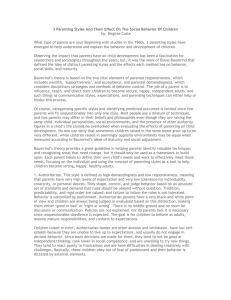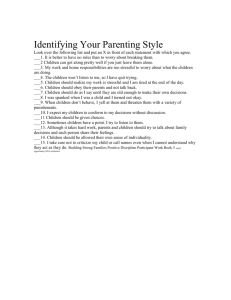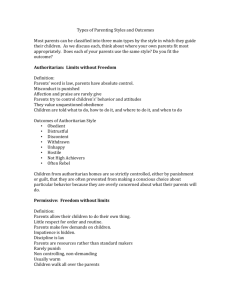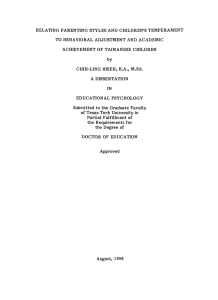Parenting Styles & Children's Temperaments: The Match
advertisement
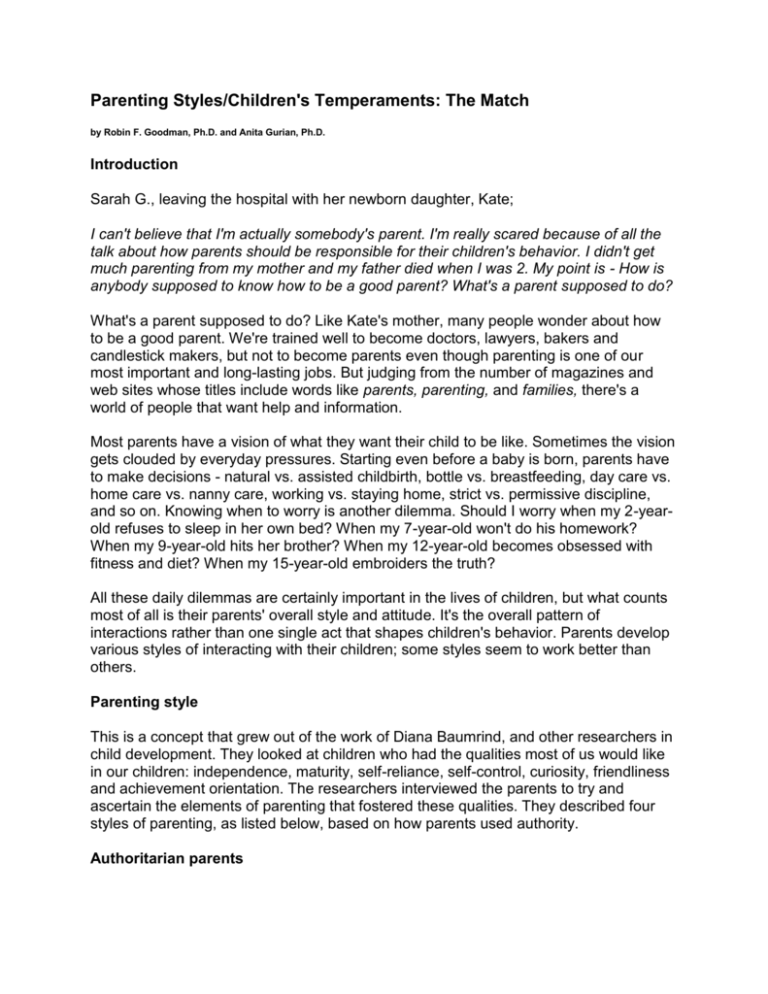
Parenting Styles/Children's Temperaments: The Match by Robin F. Goodman, Ph.D. and Anita Gurian, Ph.D. Introduction Sarah G., leaving the hospital with her newborn daughter, Kate; I can't believe that I'm actually somebody's parent. I'm really scared because of all the talk about how parents should be responsible for their children's behavior. I didn't get much parenting from my mother and my father died when I was 2. My point is - How is anybody supposed to know how to be a good parent? What's a parent supposed to do? What's a parent supposed to do? Like Kate's mother, many people wonder about how to be a good parent. We're trained well to become doctors, lawyers, bakers and candlestick makers, but not to become parents even though parenting is one of our most important and long-lasting jobs. But judging from the number of magazines and web sites whose titles include words like parents, parenting, and families, there's a world of people that want help and information. Most parents have a vision of what they want their child to be like. Sometimes the vision gets clouded by everyday pressures. Starting even before a baby is born, parents have to make decisions - natural vs. assisted childbirth, bottle vs. breastfeeding, day care vs. home care vs. nanny care, working vs. staying home, strict vs. permissive discipline, and so on. Knowing when to worry is another dilemma. Should I worry when my 2-yearold refuses to sleep in her own bed? When my 7-year-old won't do his homework? When my 9-year-old hits her brother? When my 12-year-old becomes obsessed with fitness and diet? When my 15-year-old embroiders the truth? All these daily dilemmas are certainly important in the lives of children, but what counts most of all is their parents' overall style and attitude. It's the overall pattern of interactions rather than one single act that shapes children's behavior. Parents develop various styles of interacting with their children; some styles seem to work better than others. Parenting style This is a concept that grew out of the work of Diana Baumrind, and other researchers in child development. They looked at children who had the qualities most of us would like in our children: independence, maturity, self-reliance, self-control, curiosity, friendliness and achievement orientation. The researchers interviewed the parents to try and ascertain the elements of parenting that fostered these qualities. They described four styles of parenting, as listed below, based on how parents used authority. Authoritarian parents They are highly controlling in their use of authority and rely on punishment. They value obedience as a virtue and do not encourage give-and-take. They do not expect their children to express disagreement with their decisions. The researchers found that the children of authoritarian parents tend to lack social competence, have lower self-esteem and rarely take the initiative in activities. They show less intellectual curiosity, are not spontaneous and usually rely on the voice of authority. Authoritative parents They are warm and communicate well with their children. At the same time, they retain their authority, stay in control and expect mature behavior from their children. They respect their youngsters' independence and decisions, but generally hold firm in their own positions, being clear and explicit about their point of view. The researchers found that the best adjusted children, particularly in terms of social competence, had parents with an authoritative parenting style. Both authoritarian and authoritative parents have high expectations of their children and use control but there's a difference in their styles. The authoritarian parent expects the child to unquestioningly accept parental judgments and allows the child little freedom of expression. In contrast the authoritative parent permits the child enough freedom of expression so that he or she can develop a sense of independence. Permissive parents These parents are warm and accepting, but mainly concerned about not stifling their child's creativity. They make few demands for mature behavior. The researchers found that the children of permissive parents generally have difficulty controlling their impulses, are immature and reluctant to accept responsibility. Uninvolved parents They demand little and respond minimally. In extreme cases, this parenting style might entail neglect and rejection. Here is an example of the differences in parenting styles: Debbie, aged 7, is playing with Susanna; she gets on Susanna's bike without permission and starts to ride away. An authoritarian parent says: Come back this second and give Susanna back her bike immediately. An authoritative parent uses the opportunity to teach the child, and says: The bicycle belongs to Susanna. I know you want to ride it, but why don't you talk it over with her and try and work out a system so that you can have a turn? A permissive parent believing that Debbie should be allowed to express her impulses freely, does not use the opportunity to help her solve a problem. An uninvolved parent overlooks the incident. How about children's styles? Parenting is not a one-sided activity; it's a dynamic, interactive situation, and children also have styles or temperaments that in turn affect their parents' styles and elicit different responses. For example, a mother would probably respond very differently to an aggressive child than to a shy, timid child. She might discourage the aggressive child but encourage assertive behavior in the shy child. Differences among children can be seen even in infancy. Children are born with a tendency toward certain moods and styles of reacting to people and events in their lives in specific ways. This preferred style of responding is called temperament . Researchers have delineated three broad styles of temperament: Easy children are calm, happy, regular in sleeping and eating habits, adaptable, not easily upset. Difficult children are often fussy, irregular in feeding and sleeping habits, fearful of new people and situations, easily upset, high strung, and intense in their reactions. Slow to warm up children are relatively inactive and fussy, tend to withdraw or to react negatively to novelty, but their reactions gradually become more positive with experience. No matter what the child's temperament, it's the harmony, or the goodness of fit , between mother or caregiver and child that's important. In a circular fashion, the behavior of one influences the responses of the other. However, temperament is not destiny, and family and other life experiences can make a difference. Parents who are attuned to their child's temperament and who can recognize their child's particular strengths, will find life more harmonious. In a new situation, the easy child needs little help in adapting; the slow-to-warm up child does best if not hurried and given time to think about the situation; the difficult child may need advance warning and practice of the appropriate behavior. Think about your own temperamental style and whether it meshes with your child's temperamental style. An active on-the-go parent may have to learn patience in dealing with a slow-to-warm up child. Obviously, neither parents or children fit neatly into these categories. Most parents use a combination of styles, and most children have elements of different temperamental styles. In both cases, however, one style usually predominates. What does the research tell us? Here are some principles of effective parenting to keep in mind. Be aware of your child's temperament and respect his uniqueness without comparing him to others. Encourage him to accomplish tasks at his own pace. Praising him for his ideas and achievements, however small, will enhance his self-image and make him feel capable of being independent. Make communication a priority . Take time to explain your decisions and motives and listen to your child's point of view. Encourage children to work with you on generating solutions to problems. Make your expectations clear . Setting limits will help your child develop self-control. Make her aware that her opinion is respected, but remain firm in your decisions. Be a good role model . Children take their cues from the adults around them. They learn by imitation and identification as well as discussion. Be aware of your own needs and the ways in which your role as a parent is colored by your relationship with your own parents. About the Authors Robin F. Goodman, Ph.D., is a clinical psychologist specializing in bereavement issues. Anita Gurian, Ph.D., Clinical Assistant Professor, NYU School of Medicine, is Associate Editor of the NYU Child Study Center Letter and Executive Editor of www.AboutOurKids.org. She is also the author of several books for parents and professionals.www.AboutOurKids.org. References and Related Books Baumrind, D. (l989). Rearing competent children: In W. Damon (Ed.) Child development today and tomorrow . San Francisco: Jossey-Bass. 349-378. Darling, N. & Steinberg, L. (1993). Parenting style as context: An integrative model. Psychological Bulletin , 113(3), 487-496. The Heart of Parenting: Raising an Emotionally Intelligent Child J.Gottman & J. DeClaire 1997 Simon and Schuster © 2006 Child Study Center, NYU School of Medicine
